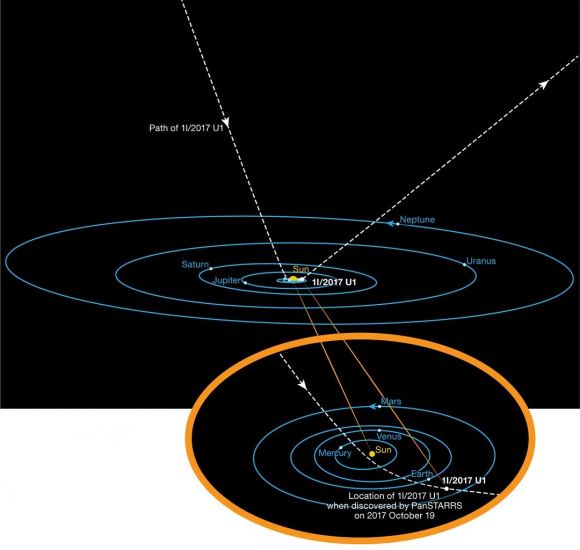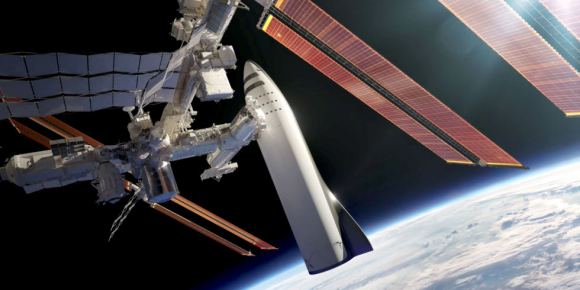Back in October, the announcement of the first interstellar asteroid triggered a flurry of excitement. Since that time, astronomers have conducted follow-up observations of the object known as 1I/2017 U1 (aka. `Oumuamua) and noted some rather interesting things about it. For example, from rapid changes in its brightness, it has been determined that the asteroid is rocky and metallic, and rather oddly-shaped.
Observations of the asteroid’s orbit have also revealed that it made its closest pass to our Sun back in September of 2017, and it is currently on its way back to interstellar space. Because of the mysteries this body holds, there are those who are advocating that it be intercepted and explored. One such group is Project Lyra, which recently released a study detailing the challenges and benefits such a mission would present.
The study, which recently appeared online under the title “Project Lyra: Sending a Spacecraft to 1I/’Oumuamua (former A/2017 U1), the Interstellar Asteroid“, was conducted by members of the Initiative for Interstellar Studies (i4iS) – a volunteer organization that is dedicated to making interstellar space travel a reality in the near future. The study was supported by Asteroid Initiatives LLC, an asteroid-prospecting company that is dedicated to facilitating the exploration and commercial exploitation of asteroids.

To recap, when Oumuamua was first observed on October 19th, 2017, by astronomers using the University of Hawaii’s Panoramic Survey Telescope and Rapid Response System (Pan-STARRS), the object (then known as C/2017 U1) was initially believed to be a comet. However, subsequent observations revealed that it was actually an asteroid and it was renamed 1I/2017 U1 (or 1I/Oumuamua).
Follow-up observations made using the ESO’s Very Large Telescope (VLT) were able to place constraints on the asteroid’s size, brightness, composition, color and orbit. These revealed that `Oumuamua measured some 400 meters (1312 feet) long, is very elongated, and spins on its axis every 7.3 hours – as indicated by the way its brightness varies by a factor of ten.
It was also determined to be rocky and metal rich, and to contain traces of tholins – organic molecules that have been irradiated by UV radiation. The asteroid also has an extremely hyperbolic orbit – with an eccentricity of 1.2 – which is currently taking it out of our Solar System. Preliminary calculations of its orbit also indicated that it originally came from the general direction of Vega, the brightest star in the northern constellation of Lyra.
Given that this asteroid is extra-solar in nature, a mission that would be capable of studying it up close could certainly tell us a great deal about the system in which it formed. It’s arrival in our system has also raised awareness about extra-solar asteroids, a new class of interstellar object that astronomers now estimate arrive in our system at a rate of about one per year.
Because of this, the team behind Project Lyra believe that studying 1I/Oumuamua would be a once-in-a-lifetime opportunity. As they state in their study:
“As 1I/‘Oumuamua is the nearest macroscopic sample of interstellar material, likely with an isotopic signature distinct from any other object in our solar system, the scientific returns from sampling the object are hard to understate. Detailed study of interstellar materials at interstellar distances are likely decades away, even if Breakthrough Initiatives’ Project Starshot, for example, is vigorously pursued. Hence, an interesting question is if there is a way to exploit this unique opportunity by sending a spacecraft to 1I/‘Oumuamua to make observations at close range.”
But of course, rendezvousing with this asteroid presents many challenges. The most obvious is that of speed, and the fact that 1I/ Oumuamua is already on its way out of our Solar System. Based on calculations of the asteroid’s orbit, it has been determined that 1I/`Oumuamua is traveling at a speed of 26 km/s – which works out to 95,000 km/hour (59,000 mph).
No mission in the history of space exploration has traveled this fast, and the fastest missions to date have only been able to manage about two-thirds that speed. This includes the fastest spaceship to leave the Solar System (Voyager 1) and the fastest spaceship at launch (the New Horizons mission). So creating a mission that could catch up to it would be a major challenge. As the team wrote:
“This [is] considerably faster than any object humanity has ever launched into space. Voyager 1, the fastest object humanity has ever built, has a hyperbolic excess velocity of 16.6 km/s. As 1I/‘Oumuamua is already leaving our solar system, any spacecraft launched in the future would need to chase it.”
However, as they go on to state, taking on this challenge would inevitably result in key innovations and developments in space exploration technology. Obviously, the launch of such a mission would need to happen sooner other than later, given the asteroid’s rapid rate of travel. But any mission that is launched within a few years’ time will not be able to take advantage of later technical developments.
As famed writer Paul Glister, one of the founders of the Tau Zero Foundation and the creator of Centauri Dreams, noted on his website:
“The challenge is formidable: 1I/’Oumuamua has a hyperbolic excess velocity of 26 km/s, which translates to a velocity of 5.5 AU/year. It will be beyond Saturn’s orbit within two years. This is much faster than any object humanity has ever launched into space.”
As such, any mission mounted to 1I/`Oumuamua would entail three notable trade-offs. These include the trade-off between travel time and delta V (i.e. the velocity of the spacecraft), the trade-off between the launch date and travel time, and the trade-off between the launch date/trip time and the characteristic energy. Characteristic energy (C3) refers to the square of the hyperbolic excess velocity, or the velocity at infinity with respect to the Sun.

Last, but not least, is the trade-off between the spacecraft’s excess velocity at launch and its excess velocity relative to the asteroid during the encounter. Excess velocity is preferable at launch, since it will result in shorter travel times. But a high excess velocity during the encounter would mean the spacecraft would have less time to conduct measurements and gather data on the asteroid itself.
With all that accounted for, the team then considers various possibilities for creating a spacecraft that would rely on an impulsive propulsion system (i.e. one with sufficiently short-duration thrust). In addition, they assume that this mission would not involve any planetary or solar fly-bys, and would fly directly to 1I/`Oumuamua. From this, some basic parameters are established which they then lay out.
“To summarize, the difficulty of reaching 1I/‘Oumuamua is a function of when to launch, the hyperbolic excess velocity, and the mission duration,” they indicate. “Future mission designers would need to find appropriate trade-offs between these parameters. For a realistic launch date in 5 to 10 years, the hyperbolic excess velocity is of the order of 33 to up to 76 km/s with an encounter at a distance far beyond Pluto (50-200AU).”
Last, but not least, the authors consider various mission architectures that are currently being developed. These include those that would prioritize urgency (i.e. launching within a few years’ time), like NASA’s Space Launch System (SLS) – which they claim would simplify the design of the mission. Another is SpaceX’s Big Falcon Rocket (BFR), which they claim could enable a direct mission by 2025 thanks to its in-space refueling technique.

However, these types of missions would also require a Jupiter flyby in order to provide a gravity-assist. Looking to more long-term techniques, which would emphasize more advanced technologies, they also consider solar sail-driven technology. This is exemplified by Breakthrough Initiatives’ Starshot concept, which would provide mission flexibility and the ability to react quickly to future unexpected events.
While this approach would entail waiting, possibility for future encounters with an interstellar asteroid, it would allow for quick response and a mission that could do away with gravity assists. It could also enable a particularly attractive mission concept, which is to send tiny swarms of probes to rendezvous with the asteroid. While this would entail significant investment, the value of the infrastructure would justify the expense, they claim.
In the end, the team determined that further research and development is necessary, which underwrites the importance of Project Lyra. As they concluded:
“[A] mission to the object will stretch the boundary of what is technologically possible today. A mission using conventional chemical propulsion system would be feasible using a Jupiter flyby to gravity- assist into a close encounter with the Sun. Given the right materials, solar sail technology or laser sails could be used… Future work within Project Lyra will focus on analyzing the different mission concepts and technology options in more detail and to down select 2 – 3 promising concepts for further development.”
It is an age-old axiom that daunting challenges are essential to innovation and change. In this respect, the appearance of `Oumuamua in our Solar System has stimulated interest in exploring interstellar asteroids. And while an opportunity to explore this asteroid may not be possible in the next few years, the arrival of future rocky interlopers in our System might just be reachable.
Further Reading: arXiv, Centauri Dreams


Long metallic object looping past the sun and heading back out of our solar system. Rama I, II, or III?
Given the high percentage of binaries in our Kuiper belt, we should consider the possibility that this started as a loose binary; result is that one is ejected, other one is captured or ends up on a less extreme orbit. it is suggested that Neptune’s moon Triton may be one-half of a kuiper belt binary, one was captured, one was ejected.
Also, `Oumuamua seems to be spinning close to the limit for breaking in two; interesting to consider whether tidal stresses at closest solar approach might have pulled any pieces off.
We have measurements and pre-covery measurements of the outbound orbit, if we find pre-covery images of the inbound orbit, it might be possible to detect changes in the orbit.
This particular interstellar asteroid has now gone well past us and heading out to Pegasus constellation. To save on the extreme difficulty of chasing Oumuamua down why not make ready for another suitable interstellar asteroid incoming?
This is addressed in the article. The idea is an audacious project might inspire advances in propulsion and materials that a safer approach wouldn’t. Kind of like the way President Kennedy inspired NASA in the 60’s.
Well, three good reasons-
–First it’s an achievable goal, other asteroids may not be. Before the slighshot around the sun `Oumuamua was on a mostly polar trajectory and was essentially be impossible to reach; after the slingshot it’s on a mostly ecliptic trajectory, which makes it difficult but possible to reach.
–Second, developing a next generation propulsion system that can reach `Oumuamua is worth it, simply based on the projectd rate of return on asteroid mining, and on asteroid defense.
–Third, on the incredibly slim possibility that it isn’t a natural object, developing OUR next generation propulsion system raises the possibility of reverse engineering materials and propulsion from another civilization. Its an incrediblly small probability, but has an incredibly high reward.
Begone, troll!!
It doesn’t look feasible within time-span available and resources to catch and study Oumuamua.
But then we can be prepared for next Oumuamua type encounter and with technology improving every day in detecting such occurance early… we may be able to hitch a free ride to outer solar space.
But…
To reach some star system within 1-2-3 generations is not possible even with this kind of free luch…
I like this idea. As well as studying an interesting object, it could later serve as an exporer of the outer solar system environment similar to what the Voyagers are doing now. And it’d be a useful intermediate step between what we’re capable of now, and the genuine interstellar probes we’d like later on.